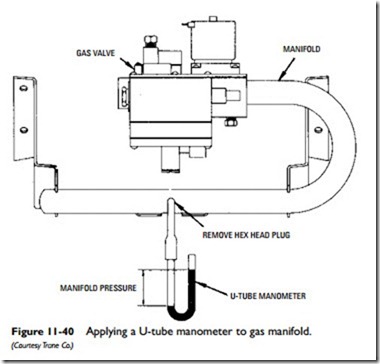Manifold Pressure Adjustment
A suitable manifold pressure is important for efficient furnace operation. If the gas pressure is too low, it will cause rough ignition, incomplete and inefficient combustion, and incorrect fan control response. An excessively high manifold pressure may cause the burners to overfire the heat exchanger. Overfiring the heat exchanger not only reduces the life of this component, but it also may result in repeated cycling of the burner on the high limit control.
Manifold pressure should be set at 3.5 in W.C. for natural gas. Control manufacturers normally preset the pressure regulator in natural-gas valves at the time of manufacture so that natural-gas units are fired at this 3.5 in W.C. rate. Only small variations in the gas flow should be made by adjusting the pressure regulator. This adjustment should never exceed plus or minus 0.3 in W.C. Major changes in the gas flow should be made by changing the size of the burner orifice (see below).
The manifold gas pressure can be tested by using a U-tube water manometer (Figure 11-40). The manometer is connected to the manifold through an opening covered by a 1⁄8-in plug cap. The pressure test must be run while the unit is operating. On Dunham- Bush gas-fired furnaces, the test is run through an opening in the gas valve (Figure 11-41). The furnace manufacturer’s installation literature should contain instructions for testing the manifold pressure.
Once you have determined the manifold pressure, you may find it necessary to adjust it for better operating characteristics. Manifold pressure can be increased by turning the adjusting screw clockwise, and decreased by turning it counterclockwise.
LP gas units are fired at 11 in W.C. manifold pressure. LP gas (propane and butane) is heavier than natural gas and has a higher heating value. As a result, LP gas needs more primary air for combustion. Thus, a higher manifold pressure is required to induce the greater volume of primary air into the burner than is the case in natural gas units An LP furnace does not have a pressure regulator in the gas valve. Pressure adjustments are made by means of the regulator at the supply tank. These adjustments must be made by the installer and regularly checked by the serviceman for possible malfunctions.
Related posts:
Incoming search terms:
- lp gas furnace gas presure
- does low propane have an affect on my furnace
- maxium lp pressure furnace control valve
- gas pressure adjustment on furnace
- gas valve is too high
- how important is a dump valve on a propane furnace
- manifold gas pressure for LP Gas
- adjust furnace manifold pressure
- what happens to a gas at low pressures and high temp
- how to increase gas pressure on hvac unit
- Hvac gas pressure
- furnace gas pressure too high
- is there a way to check manifold pressure in furnace without a guage
- boiler burner manifold pressure too high
- low manifold gas pressure
- how do i adjust the gas pressure on my furnace
- How is gas pressure adjusted on a furnace
- gas pressure to furnace to low
- manifold pressure on propane furnace
- what should the pressure be on a manifold side of a furnace propane
- natural gas furnace manifold pressure at 5 indtead of 3 5
- Furance (Direct Fired) mail
- lp pressure on furnace
- does lack of pressure on propane cause poor combustion
- what manifold pressure should a lp gas valve be in wc
- how to find furmace manifold pressure
- low pressure natural gas burner language:en
- liquid propaine manifold pressure hvac
- how to regulate pressure in furnace
- how to set a furnace regulator for propane
- how to set gas pressure on a residential gas boiler?
- HVAC furnace propane regulator
- low gas pressure to furnace
- low gas pressure causing high limit
- is a furnace gas valve adjustment cap necessary
- how to check regulated gas pressure high efficiency furnace
- why won\t pressure from gas valve increase
- Adjust propane pressure for furnace
- boiler gas manifold pressure too high
- can lower wc below 3 5 wc
- common manifold pressure for natural gpropane
- condensing furnace manifold pressure
- Continuous Carburizing Furnace manufacturers
- gas fired burners manufacturers mail
- gas pressure regulator testing
- gas pressure too high on furnace
- adjusting gas manifold pressure gas furnace
- heater gas valve adjustment
- How can i check pressure on my lp gas furnace in my camer
- furnace gas valve pressure adjustment how to
